light MAZDA MX5 MIATA 2016 Owners Manual
[x] Cancel search | Manufacturer: MAZDA, Model Year: 2016, Model line: MX5 MIATA, Model: MAZDA MX5 MIATA 2016Pages: 526, PDF Size: 10.44 MB
Page 166 of 526

4–62
When Driving
Drive Selection
Drive Selection Switch
Press the drive selection switch forward
(“
”) to select the sport mode.
Pull the drive selection switch back
(“
”) to cancel the sport mode.
NOTE
When the ignition is switched off, the
sport mode is canceled. Depending on the driving conditions
when sport mode is selected, the vehicle
may perform shift-down or slightly
accelerate.
Select Mode Indication
When the sport mode is selected, the select
mode indication turns on in the instrument
cluster.
NOTE
If the mode cannot be switched to drive
mode, the select mode indication flashes to
notify the driver.
MX-5_8EU4-EA-15D_Edition4.indb 622016/01/20 11:05:18
Page 167 of 526

4–63
When Driving
Power Steering
Power Steering
Power steering is only operable when
the engine is running. If the engine is
off or if the power steering system is
inoperable, you can still steer, but it
requires more physical effort.
If the steering feels stiffer than usual
during normal driving or the steering
vibrates, consult an Authorized Mazda
Dealer.
The warning light notifies the driver
of system abnormalities and operation
conditions.
Refer to Warning Lights on page
4-16.
CAUTION
Never hold the steering wheel to the
extreme left or right for more than 5
seconds with the engine running. This
could damage the power steering
system.
MX-5_8EU4-EA-15D_Edition3.indb 632015/10/21 16:53:26
Page 168 of 526

4–64
When Driving
i-ACTIVSENSE
*Some models.
i-ACTIVSENSE*
i-ACTIVSENSE is a collective term covering a series of advanced safety a\
nd driver support
systems which make use of a Forward Sensing Camera (FSC) and radar sen\
sors.
Because each system has its limitations, always drive carefully and do not rely solely on the
systems.
Driver awareness support systems
Nighttime visibility
Adaptive Front Lighting System (AFS)
........................................................................\
......4-65
High Beam Control System (HBC)
........................................................................\
............4-66
Left/right side and rear side detection
Lane Departure Warning System (LDWS)
........................................................................\
.4-69
Blind Spot Monitoring (BSM) System
........................................................................\
.......4-74
Rear obstruction detection when leaving a parking space
Rear Cross Traffic Alert (RCTA)
........................................................................\
................4-81
Camera and Sensors
Forward sensing camera (FSC)
The Forward Sensing Camera (FSC) determines the conditions ahead of th\
e vehicle while
traveling at night and detects traffic lanes. The following systems also use the Forward
Sensing Camera (FSC).
High Beam Control system (HBC) Lane Departure Warning System (LDWS)
The Forward Sensing Camera (FSC) is installed at the top of the windsh\
ield near the
rearview mirror.
Refer to Forward Sensing Camera (FSC) on page 4-84.
Radar sensors (rear)
The radar sensors (rear) function by detecting the radio waves reflected off a vehicle
approaching from the rear or an obstruction sent from the radar sensors.\
The following
systems also use the radar sensors (rear).
Blind Spot Monitoring (BSM) System Rear Cross Traffic Alert (RCTA)
The radar sensors (rear) are installed inside the rear bumper, one each on the left and right
sides.
Refer to Radar Sensors (Rear) on page 4-87.
MX-5_8EU4-EA-15D_Edition3.indb 642015/10/21 16:53:26
Page 169 of 526
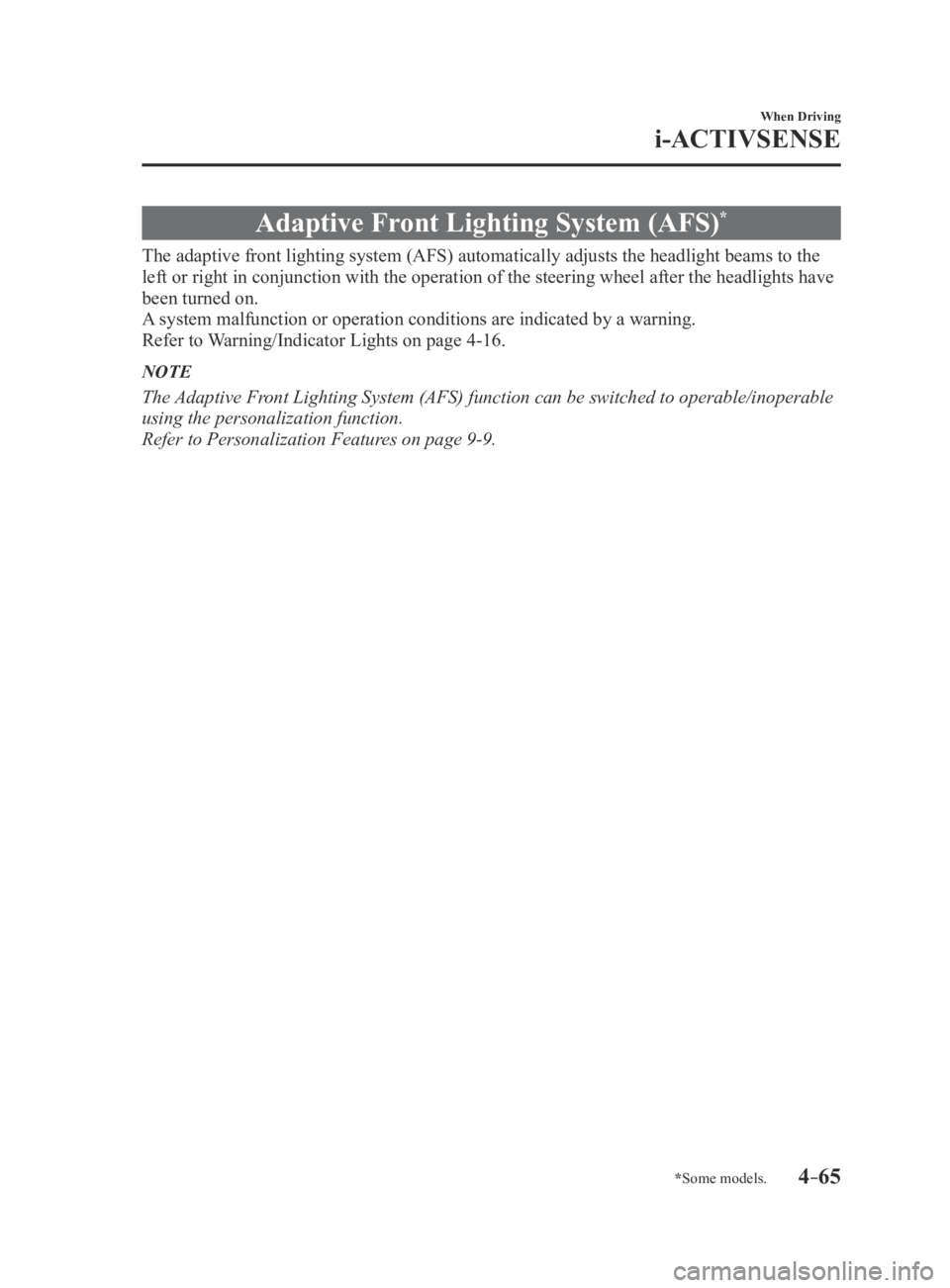
4–65
When Driving
i-ACTIVSENSE
*Some models.
Adaptive Front Lighting System (AFS)*
The adaptive front lighting system (AFS) automatically adjusts the hea\
dlight beams to the
left or right in conjunction with the operation of the steering wheel af\
ter the headlights have
been turned on.
A system malfunction or operation conditions are indicated by a warning.
Refer to Warning/Indicator Lights on page 4-16.
NOTE
The Adaptive Front Lighting System (AFS) function can be switched to operable/inopera\
ble
using the personalization function.
Refer to Personalization Features on page 9-9.
MX-5_8EU4-EA-15D_Edition3.indb 652015/10/21 16:53:26
Page 170 of 526
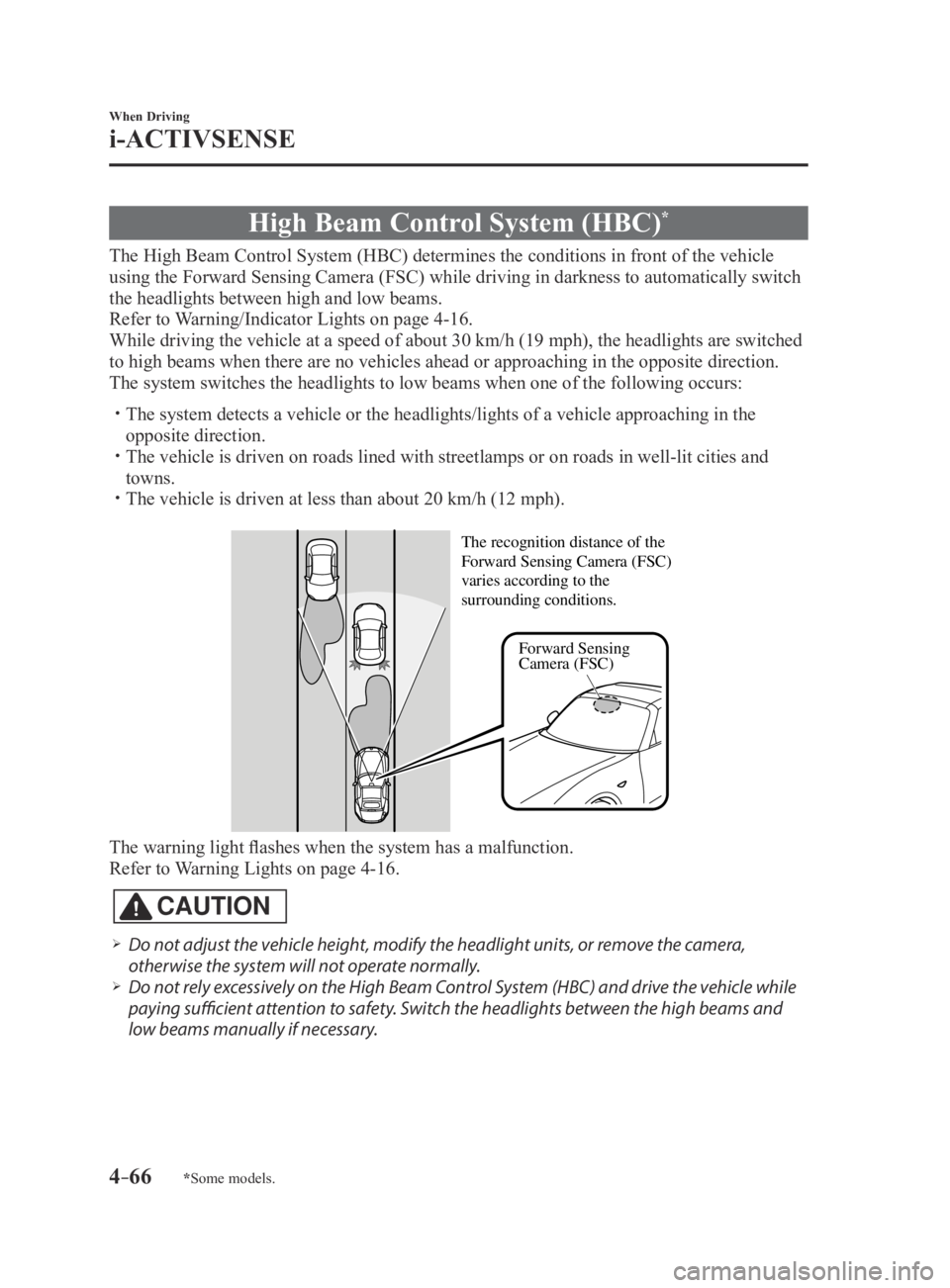
4–66
When Driving
i-ACTIVSENSE
*Some models.
High Beam Control System (HBC)*
The High Beam Control System (HBC) determines the conditions in front of the vehicle
using the Forward Sensing Camera (FSC) while driving in darkness to au\
tomatically switch
the headlights between high and low beams.
Refer to Warning/Indicator Lights on page 4-16.
While driving the vehicle at a speed of about 30 km/h (19 mph), the he\
adlights are switched
to high beams when there are no vehicles ahead or approaching in the opp\
osite direction.
The system switches the headlights to low beams when one of the followin\
g occurs:
The system detects a vehicle or the headlights/lights of a vehicle appro\
aching in the
opposite direction. The vehicle is driven on roads lined with streetlamps or on roads in wel\
l-lit cities and
towns. The vehicle is driven at less than about 20 km/h (12 mph).
Forward Sensing
Camera (FSC)
The recognition distance of the
Forward Sensing Camera (FSC)
varies according to the
surrounding conditions.
The warning light flashes when the system has a malfunction.
Refer to Warning Lights on page
4-16.
CAUTION
Do not adjust the vehicle height, modify the headlight units, or remove the camera,
otherwise the system will not operate normally. Do not rely excessively on the High Beam Control System (HBC) and drive the vehicle while
paying sufficient attention to safety. Switch the headlights between the high beams and
low beams manually if necessary.
MX-5_8EU4-EA-15D_Edition4.indb 662016/01/20 11:05:18
Page 171 of 526
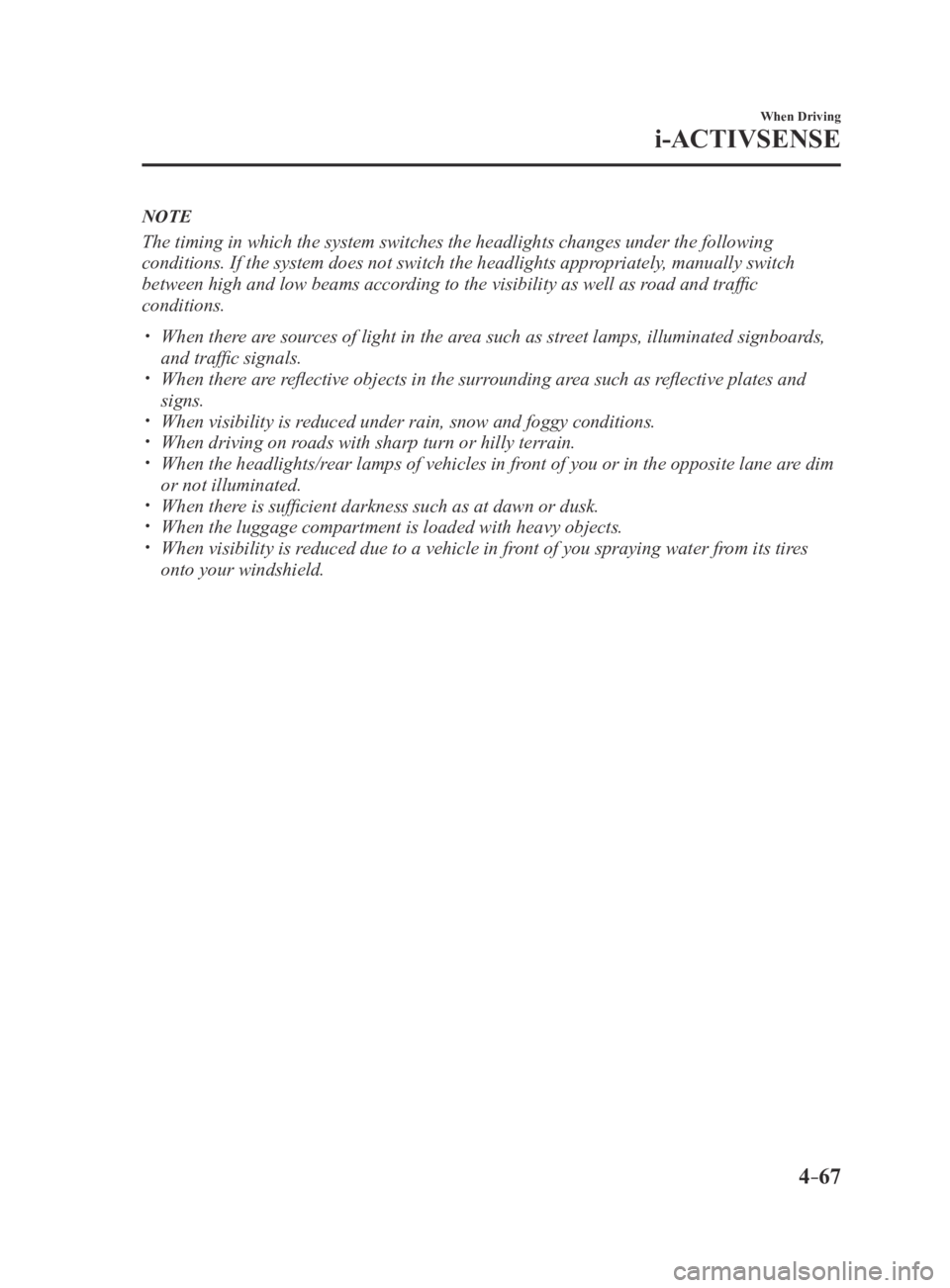
4–67
When Driving
i-ACTIVSENSE
NOTE
The timing in which the system switches the headlights changes under the\
following
conditions. If the system does not switch the headlights appropriately, manually switch
between high and low beams according to the visibility as well as road and traffic
conditions.
When there are sources of light in the area such as street lamps, illuminated signboards,
and traffic signals. When there are reflective objects in the surrounding area such as reflective plates and
signs. When visibility is reduced under rain, snow and foggy conditions. When driving on roads with sharp turn or hilly terrain. When the headlights/rear lamps of vehicles in front of you or in the opposite lane are dim
or not illuminated. When there is sufficient darkness such as at dawn or dusk. When the luggage compartment is loaded with heavy objects. When visibility is reduced due to a vehicle in front of you spraying water from its tires
onto your windshield.
MX-5_8EU4-EA-15D_Edition3.indb 672015/10/21 16:53:27
Page 172 of 526
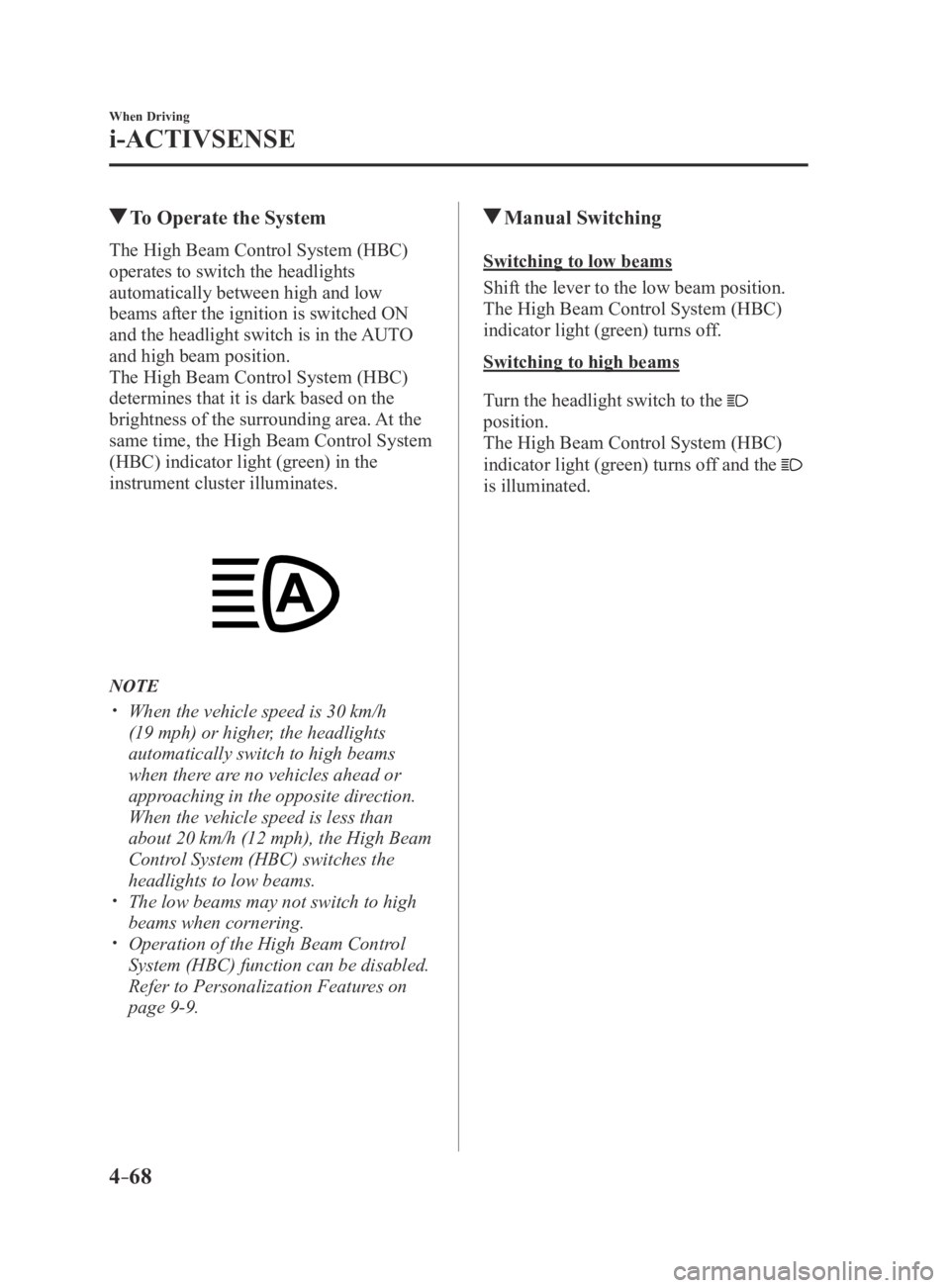
4–68
When Driving
i-ACTIVSENSE
To Operate the System
The High Beam Control System (HBC)
operates to switch the headlights
automatically between high and low
beams after the ignition is switched ON
and the headlight switch is in the AUTO
and high beam position.
The High Beam Control System (HBC)
determines that it is dark based on the
brightness of the surrounding area. At the
same time, the High Beam Control System
(HBC) indicator light (green) in the
instrument cluster illuminates.
NOTE
When the vehicle speed is 30 km/h
(19 mph) or higher, the headlights
automatically switch to high beams
when there are no vehicles ahead or
approaching in the opposite direction.
When the vehicle speed is less than
about 20 km/h (12 mph), the High Beam
Control System (HBC) switches the
headlights to low beams.
The low beams may not switch to high
beams when cornering. Operation of the High Beam Control
System (HBC) function can be disabled.
Refer to Personalization Features on
page 9-9.
Manual Switching
Switching to low beams
Shift the lever to the low beam position.
The High Beam Control System (HBC)
indicator light (green) turns off.
Switching to high beams
Turn the headlight switch to the
position.
The High Beam Control System (HBC)
indicator light (green) turns off and the
is illuminated.
MX-5_8EU4-EA-15D_Edition4.indb 682016/01/20 11:05:19
Page 173 of 526

4–69
When Driving
i-ACTIVSENSE
*Some models.
Lane Departure Warning System (LDWS)*
The LDWS system notifies the driver that the vehicle may be deviating from its lane.
The system detects the white or yellow lines on the traffic lane using the Forward Sensing
Camera (FSC) and if it determines that the vehicle may be deviating from its lane, it notifies
the driver by flashing the LDWS warning light and activating the LDWS warning beep.
Use the LDWS when you drive the vehicle on roads with white or yellow li\
nes.
Refer to Forward Sensing Camera on page 4-84.
Forward Sensing Camera
(FSC)
LDWS warning light
The warning light illuminates when the system has a malfunction.
Refer to Warning Lights on page 4-16.
WARNING
Do not use the LDWS under the following conditions:
The system may not operate adequately according to the actual driving conditions,
resulting in an accident.
Driving on roads with tight curves. Driving under bad weather conditions (rain, fog, and snow).
The functions of the LDWS have limitations:
Always stay on course using the steering wheel and drive with care. The system is not
designed to compensate for a driver’s lack of caution and if you rely too much on the
LDWS it could lead to an accident. The driver is responsible for assuring lane changes and
other maneuvers. Always pay attention to the direction in which the vehicle is traveling
and the vehicle’s surroundings.
MX-5_8EU4-EA-15D_Edition3.indb 692015/10/21 16:53:28
Page 174 of 526
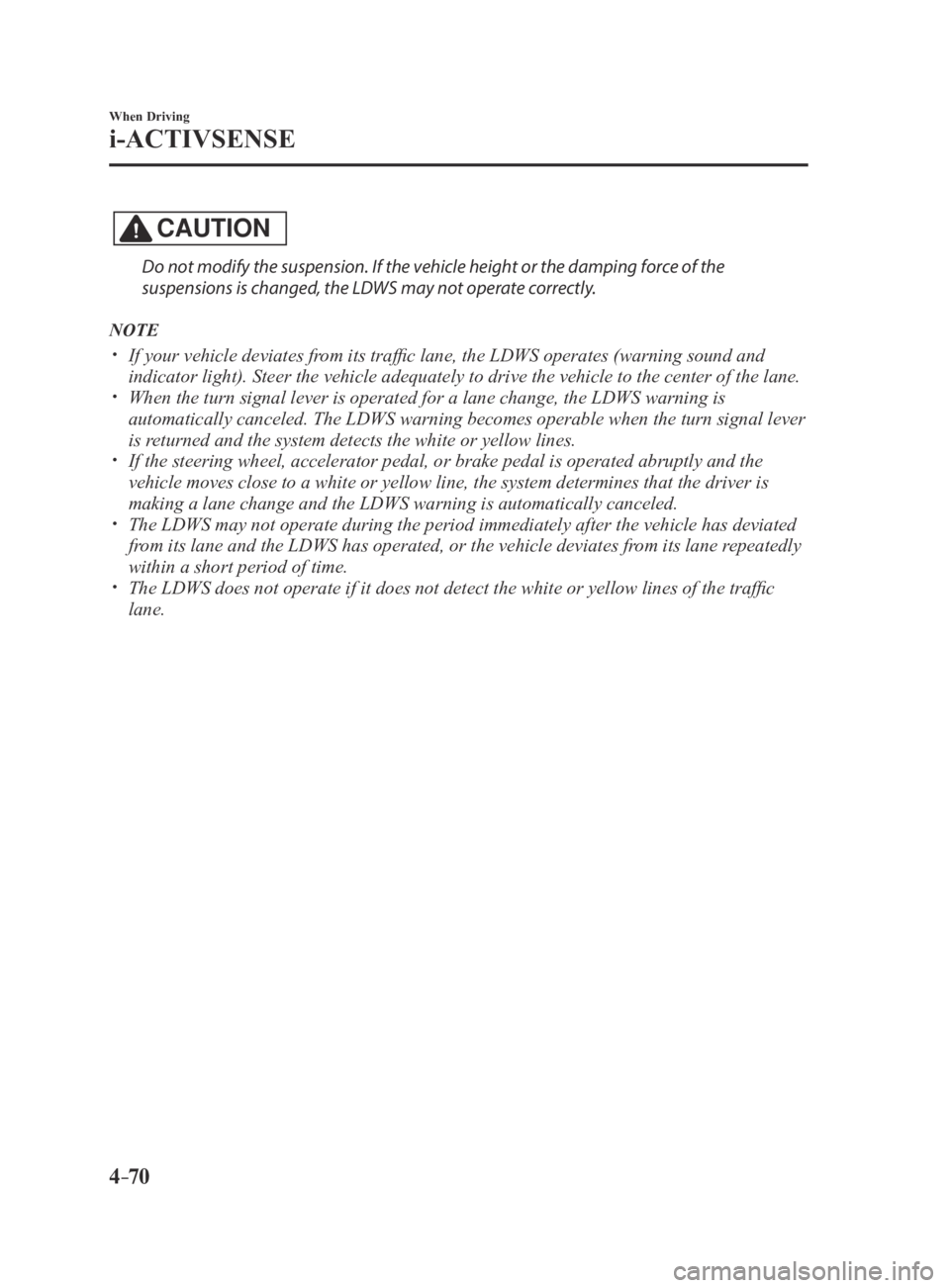
4–70
When Driving
i-ACTIVSENSE
CAUTION
Do not modify the suspension. If the vehicle height or the damping force of the
suspensions is changed, the LDWS may not operate correctly.
NOTE
If your vehicle deviates from its traffic lane, the LDWS operates (warning sound and
indicator light). Steer the vehicle adequately to drive the vehicle to \
the center of the lane. When the turn signal lever is operated for a lane change, the LDWS warni\
ng is
automatically canceled. The LDWS warning becomes operable when the turn \
signal lever
is returned and the system detects the white or yellow lines.
If the steering wheel, accelerator pedal, or brake pedal is operated abr\
uptly and the
vehicle moves close to a white or yellow line, the system determines tha\
t the driver is
making a lane change and the LDWS warning is automatically canceled.
The LDWS may not operate during the period immediately after the vehicle\
has deviated
from its lane and the LDWS has operated, or the vehicle deviates from its lane repeatedly
within a short period of time.
The LDWS does not operate if it does not detect the white or yellow lines of the traffic
lane.
MX-5_8EU4-EA-15D_Edition3.indb 702015/10/21 16:53:28
Page 175 of 526

4–71
When Driving
i-ACTIVSENSE
Under the following conditions, the LDWS may not be able to detect white\
or yellow lines
correctly and the LDWS may not operate correctly.
If an object placed on the dashboard is reflected in the windshield and picked up by the
camera. Heavy luggage is loaded in the luggage compartment the vehicle is inclin\
ed. The tire pressures are not adjusted to the specified pressure. When the vehicle is driven on the entry and exit to or from the rest area or tollgate of a
highway. The white or yellow lines are less visible because of dirt or paint flaking. The vehicle ahead is running near a white or yellow line and the line is\
less visible. A white or yellow line is less visible because of bad weather (rain, fog\
, or snow). The vehicle is driven on a temporary lane or section with a closed lane \
due to
construction. A misleading line is picked up on the road such as a temporary line for construction,
or because of shade, lingering snow, or grooves filled with water. The surrounding brightness suddenly changes such as when entering or exiting a
tunnel. The illumination of the headlights is weakened because of dirt or the op\
tical axis is
deviated. The windshield is dirty or foggy. Back-light is reflecting from the road surface. The road surface is wet and shiny after rain, or there are puddles on the road. The shade of a guardrail parallel to a white or yellow line is on the road. The width of a lane is excessively narrow or wide. The road is excessively uneven. The vehicle is shaken after hitting a road bump. There are two or more adjacent white or yellow lines. There are various road markings or lane markings of various shapes near an
intersection.
MX-5_8EU4-EA-15D_Edition3.indb 712015/10/21 16:53:28